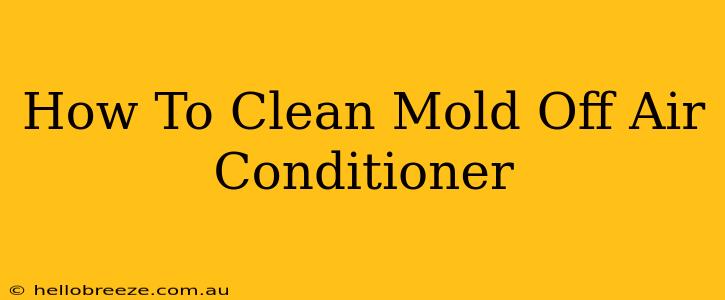Mold growth in your air conditioner is not only unsightly but can also negatively impact your indoor air quality and potentially your health. A musty smell coming from your AC unit is a telltale sign of a mold problem. This comprehensive guide will walk you through how to effectively clean mold from your air conditioner, both the exterior and interior components. Remember, safety first! Always disconnect the power supply before beginning any cleaning process.
Identifying Mold in Your Air Conditioner
Before you start cleaning, it's crucial to accurately identify mold. Mold often appears as fuzzy, dark spots, typically black, green, or gray, but can also be other colors. It can grow on various parts of your AC unit, including:
- Exterior Fins: These are the metal fins at the back of the unit.
- Air Filter: The air filter is a common breeding ground for mold due to trapped dust and moisture.
- Interior Components (Advanced): Cleaning interior components requires more expertise and potentially professional help. We'll touch on this later.
Tools and Materials You'll Need
Gather these supplies before you begin to ensure a smooth cleaning process:
- Safety Glasses: Protect your eyes from flying debris and cleaning solutions.
- Gloves: Protect your hands from mold and cleaning chemicals.
- Soft Brush: A soft brush or old toothbrush is perfect for scrubbing delicate areas.
- Vacuum Cleaner with a Brush Attachment: Essential for removing loose mold and debris.
- Mold Cleaning Solution: You can use a commercial mold cleaner or make your own using a mixture of water and white vinegar (a natural and effective mold killer).
- Spray Bottle: For easy application of your cleaning solution.
- Cloth or Sponge: For wiping down surfaces.
- Ladder (if necessary): For safely reaching the exterior unit.
- Air Conditioner Cover (optional): Helps prevent future mold growth.
Cleaning the Exterior of Your Air Conditioner
This is the easiest part and should be done regularly to prevent mold buildup:
- Disconnect the Power: This is the most critical step! Turn off the breaker switch that controls your AC unit.
- Vacuum the Fins: Use the brush attachment to gently remove loose dirt, dust, and debris from the exterior fins. Be careful not to bend the fins.
- Prepare Cleaning Solution: Mix your chosen mold cleaning solution according to instructions.
- Apply and Scrub: Spray the cleaning solution onto the fins and gently scrub with your soft brush. Pay attention to areas with visible mold.
- Rinse and Dry: Rinse the fins thoroughly with clean water. Allow them to air dry completely before turning the power back on.
Cleaning the Air Filter
The air filter is a prime location for mold growth:
- Locate and Remove: Find your air filter (usually located inside the unit). Remove it carefully.
- Vacuum: Use the vacuum cleaner to remove as much loose debris and mold as possible.
- Wash or Replace: Some filters are washable; others are disposable. Consult your AC unit's manual for instructions. If washable, gently wash the filter with your mold cleaning solution, rinse thoroughly, and allow it to dry completely before reinstalling. If disposable, replace with a new filter.
Cleaning Interior Components (Professional Help Recommended)
Cleaning the interior components of your air conditioner—like the evaporator coil and drain pan—requires more advanced knowledge and potentially specialized tools. Attempting to clean these components without proper knowledge can damage your AC unit. It's best to contact a qualified HVAC technician for this task. They have the expertise and equipment to clean these areas safely and effectively.
Preventing Mold Growth in Your Air Conditioner
Prevention is key to avoiding future mold problems. Here are some tips:
- Regular Cleaning: Clean your air conditioner's exterior and filter regularly, at least once a month during peak usage seasons.
- Proper Ventilation: Ensure adequate ventilation in the area surrounding your AC unit to prevent moisture buildup.
- Regular Maintenance: Schedule regular professional maintenance checks for your AC unit to identify and address potential issues early.
- Air Conditioner Cover: Consider using an air conditioner cover during periods when the unit isn't in use.
By following these steps and implementing preventive measures, you can keep your air conditioner clean, mold-free, and running efficiently for years to come. Remember, safety is paramount. If you're unsure about any part of the cleaning process, consult a professional.

